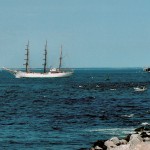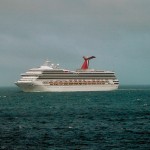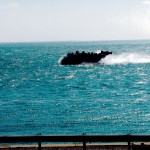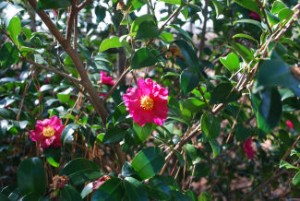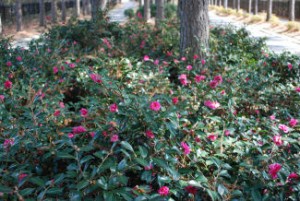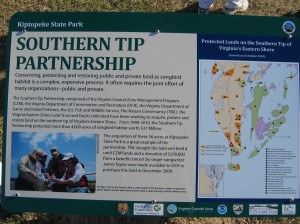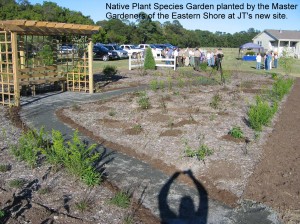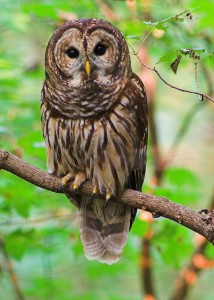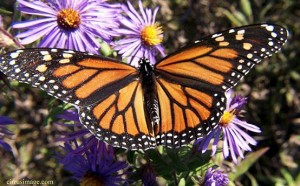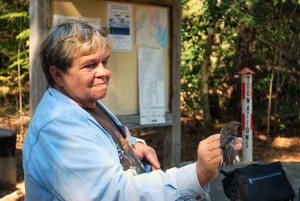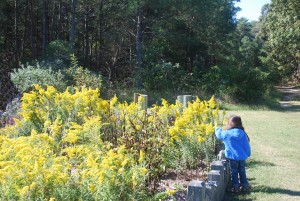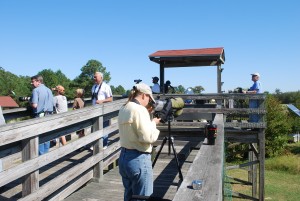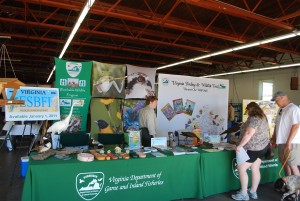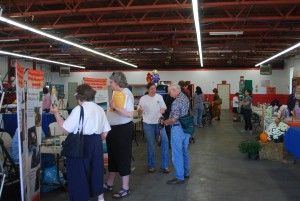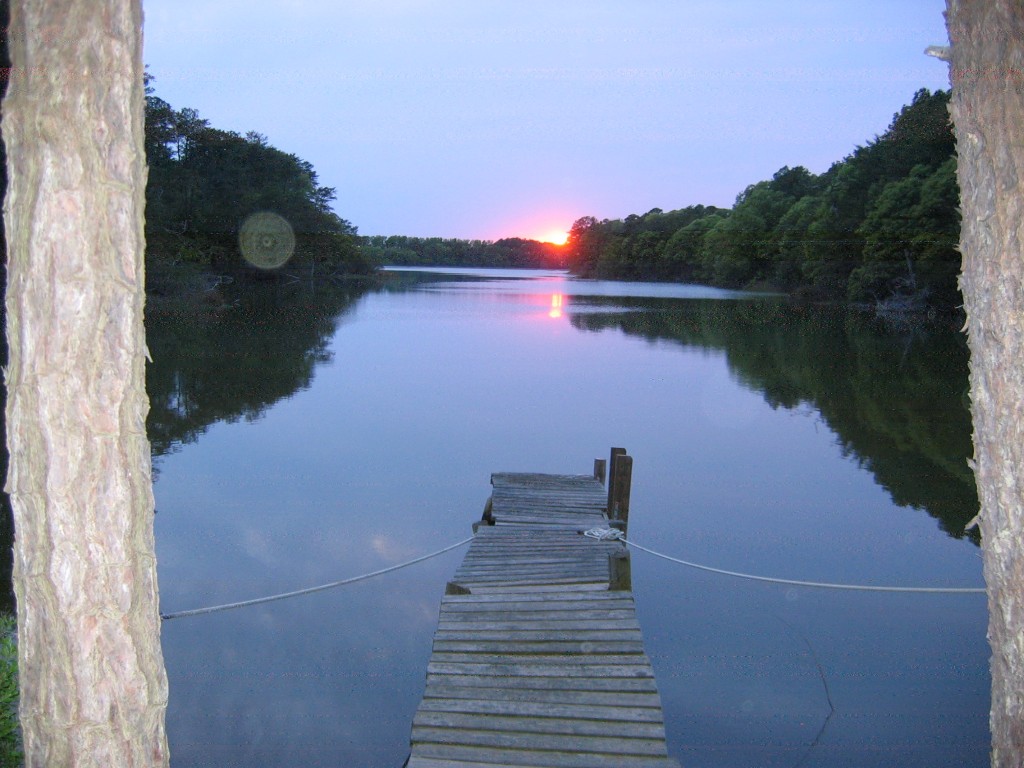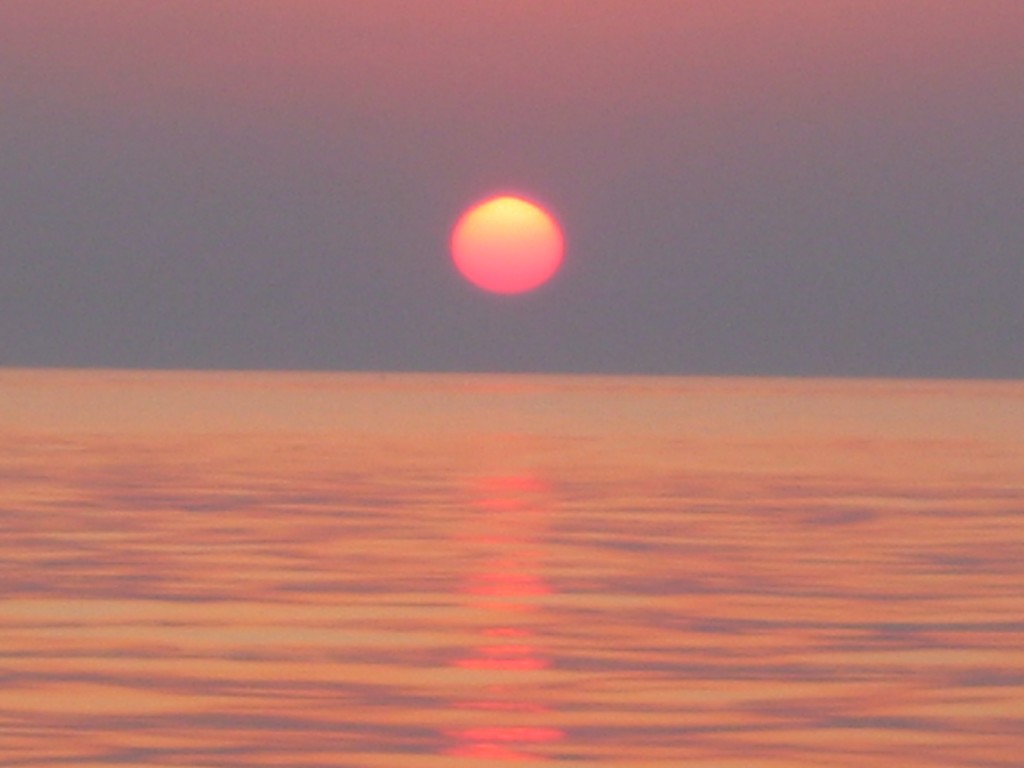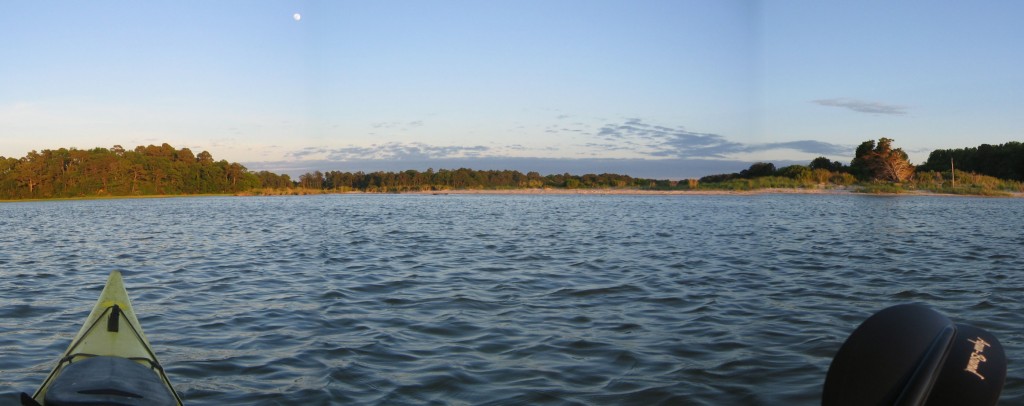A few weeks ago, David Kabler, broker for Blue Heron Realty Co.’s Cape Charles, VA branch office, wrote an interesting post about an unusual tour he and other members of the Cape Charles Coast Guard Auxillery were priviledged to be able to take of the inner workings of the Chesapeake Bay Bridge Tunnel complex which connects the Eastern Shore to the Virginia Beach/Norfolk area of mainland Virginia. Dave’s post was primarily about the interesting things the group learned about the history, construction and operation of this amazing structure, known far and wide as one of the great engineering marvels of the modern world. Like Dave, I too have traveled “The Bridge” countless times, on the old single lane span and the new double lane span, in good weather and bad, during the day and in the middle of the night, “going across the Bay”, the old Eastern Shore colloquialism, a throw-back to the days when traveling for several hours by ferry was the only way to cross these wide waters, a significant trip for sure. People didn’t say they “were going to Virginia Beach”, they said “I’m going across the Bay” and that native phrase is as alive and well today as it was 50 years ago. I love traveling on this Bridge, for reasons too numerous to count, but let me give it a try.
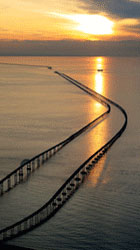 My family and I have lived on the Eastern Shore of Virginia for over 25 years. We love it, wouldn’t want to live anywhere else, we treasure the Shore’s beautiful lands, the relaxed pace of life, its friendly people. But I also love the shopping malls, the numerous special events, the art institutions like Norfolk’s Chrysler Hall and Harrison Opera House as well as the numerous restaurants featuring cuisines from all over the world, all to be found less than an hour away in Virginia Beach and Norfolk. And then there are the points further west but still within a 2-4 hour’s drive of the Eastern Shore, fabulous and historic cities like Williamsburg, Richmond, Charlottesville and Washington DC, all of which which we visit for one occasion or another at least several times a year. In fact, we just got back from a week-end trip to D.C. and Richmond last month and are planning to make our annual fall “apple trek” to Carter’s Mountain in Charlottesville later this month. So the Chesapeake Bay Bridge-Tunnel is our easy, fast, safe and truly beautiful connection from our splendid low-key, relaxed cocoon here on the Eastern Shore to the wider, faster, ultra busy-busy world on the other side of the Chesapeake Bay, our tether to a metropolitan lifestyle but “on-demand”, our demand. It’s a lifeline from one set of interests to another, a way we Eastern Shore residents have found to have our cake and eat it too, a time machine, enabling the traveler to emerge smiling from one type of world into another —- in less than an hour !
My family and I have lived on the Eastern Shore of Virginia for over 25 years. We love it, wouldn’t want to live anywhere else, we treasure the Shore’s beautiful lands, the relaxed pace of life, its friendly people. But I also love the shopping malls, the numerous special events, the art institutions like Norfolk’s Chrysler Hall and Harrison Opera House as well as the numerous restaurants featuring cuisines from all over the world, all to be found less than an hour away in Virginia Beach and Norfolk. And then there are the points further west but still within a 2-4 hour’s drive of the Eastern Shore, fabulous and historic cities like Williamsburg, Richmond, Charlottesville and Washington DC, all of which which we visit for one occasion or another at least several times a year. In fact, we just got back from a week-end trip to D.C. and Richmond last month and are planning to make our annual fall “apple trek” to Carter’s Mountain in Charlottesville later this month. So the Chesapeake Bay Bridge-Tunnel is our easy, fast, safe and truly beautiful connection from our splendid low-key, relaxed cocoon here on the Eastern Shore to the wider, faster, ultra busy-busy world on the other side of the Chesapeake Bay, our tether to a metropolitan lifestyle but “on-demand”, our demand. It’s a lifeline from one set of interests to another, a way we Eastern Shore residents have found to have our cake and eat it too, a time machine, enabling the traveler to emerge smiling from one type of world into another —- in less than an hour !
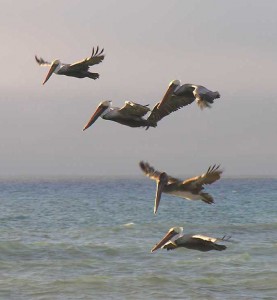 Not only does the Bridge allow the practical physical connection of our slender peninsula to the Mother Ship of mainland Virginia, from an aesthetic point of view, the Bridge itself is a beautiful sight to see and the sights and sounds of a trip on the Bridge are extraordinary. The 17 mile crossing point is placed approximately where the Chesapeake Bay and Atlantic Ocean merge so it’s like traveling over a water wonderland, seabirds swooping and calling overhead, flocks of pelicans skimming over the waves, that little flock of cormorants usually perched on the railing outside the second tunnel or what seem to be billions of chattering gulls, diving madly into the water to take advantage of a passing school of menhaden. In summer sometimes we’ ll be lucky enough to see a school of dolphins jumping — this area is the nursery ground for the bottlenose dolphin. The Eastern Shore is a critical part of the Atlantic Flyway and autumn brings sights of large bands of migrating songbirds and raptors swooping gaily through the skies or taking a break in the sanctuary of Fisherman’s Island ( seen just as one gets on ( or off) the main span ). In winter we keep our eyes peeled for the small number of humpback whales that migrate through between December and March but have never been fortunate enough to see one, still hoping though.
Not only does the Bridge allow the practical physical connection of our slender peninsula to the Mother Ship of mainland Virginia, from an aesthetic point of view, the Bridge itself is a beautiful sight to see and the sights and sounds of a trip on the Bridge are extraordinary. The 17 mile crossing point is placed approximately where the Chesapeake Bay and Atlantic Ocean merge so it’s like traveling over a water wonderland, seabirds swooping and calling overhead, flocks of pelicans skimming over the waves, that little flock of cormorants usually perched on the railing outside the second tunnel or what seem to be billions of chattering gulls, diving madly into the water to take advantage of a passing school of menhaden. In summer sometimes we’ ll be lucky enough to see a school of dolphins jumping — this area is the nursery ground for the bottlenose dolphin. The Eastern Shore is a critical part of the Atlantic Flyway and autumn brings sights of large bands of migrating songbirds and raptors swooping gaily through the skies or taking a break in the sanctuary of Fisherman’s Island ( seen just as one gets on ( or off) the main span ). In winter we keep our eyes peeled for the small number of humpback whales that migrate through between December and March but have never been fortunate enough to see one, still hoping though.
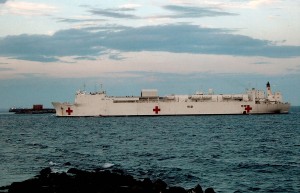 Large tankers traveling the Baltimore Channel on the horizon, sailboats and power boats crusing along, doing their fishing or crusing thing are a common but nevertheless, interesting sight. Sometimes, if you’re lucky, near the south tunnel you’ll see one of the destroyers or a submarine, maybe even a huge hovercraft, from Naval Station Norfolk, one of the Navy’s largest U.S. bases, traveling through the open navigation channel for large ships at Thimble Shoal Tunnel, the south tunnel.
Large tankers traveling the Baltimore Channel on the horizon, sailboats and power boats crusing along, doing their fishing or crusing thing are a common but nevertheless, interesting sight. Sometimes, if you’re lucky, near the south tunnel you’ll see one of the destroyers or a submarine, maybe even a huge hovercraft, from Naval Station Norfolk, one of the Navy’s largest U.S. bases, traveling through the open navigation channel for large ships at Thimble Shoal Tunnel, the south tunnel. 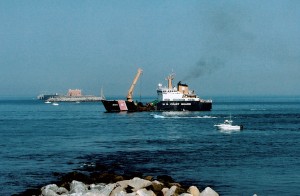 Once we happened to be traveling on that section of the Bridge just as the aircraft carrier USS Enterprise passed through, deploying for the Middle East. She is quite an impressive sight. And a couple of months ago, for the first time ever, I saw a helicopter carrier ship which had just passed through the channel, going east– I pulled over at the special viewing area on the tunnel’s 5 acre manmade island to watch for a few minutes and saw flying out, one by one, to land on her deck, about 8 helicopters, no doubt deploying to some faraway part of the world, leaving home and family behind in Virginia Beach. And quite frequently we see huge cargo ships up close, loaded with containers to be off-loaded at Norfolk Terminals. From time to time we’ve seen ocean liners passing through the channel over the tunnel, headed to the Cruise Ship Terminal next to Nauticus Museum in Norfolk, these ships passing in the night are especially pretty, lights blazing from long rows of portholes. There’s always, always something interesting going on as one travels “across the Bay”.
Once we happened to be traveling on that section of the Bridge just as the aircraft carrier USS Enterprise passed through, deploying for the Middle East. She is quite an impressive sight. And a couple of months ago, for the first time ever, I saw a helicopter carrier ship which had just passed through the channel, going east– I pulled over at the special viewing area on the tunnel’s 5 acre manmade island to watch for a few minutes and saw flying out, one by one, to land on her deck, about 8 helicopters, no doubt deploying to some faraway part of the world, leaving home and family behind in Virginia Beach. And quite frequently we see huge cargo ships up close, loaded with containers to be off-loaded at Norfolk Terminals. From time to time we’ve seen ocean liners passing through the channel over the tunnel, headed to the Cruise Ship Terminal next to Nauticus Museum in Norfolk, these ships passing in the night are especially pretty, lights blazing from long rows of portholes. There’s always, always something interesting going on as one travels “across the Bay”.
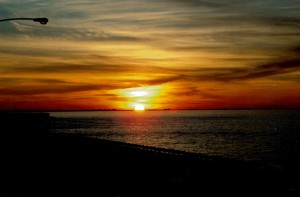 When you first get on the Bridge you cannot see the land on the other side, you are just suspended above what seems to be an endless expanse of water, blue and glistening on a sunny day, deep pinks and violets when traveling at sunset, very, very special on full moon nights, the golden-white moonbeams casting a long trail across dark waters, a perfect illustration for the nursery poem ” Winken, Blinken and Nod”, as they sailed off into a river of crystal light with the glorious stars above, one of the most beautiful times to be on the Bridge. And in my estimation, one of the prettiest sights you’ll see on the Shore is the gracefully curved shoreline of Fisherman’s Island Wildlife Refuge on a sunny day as viewed from the top of the homeward bound north span’s high level bridge, the sparkling blue waters, waves breaking on the shore, lacy white sea foam, the glistening white sands, green beach grass, the infinite waters of the Atlantic beyond, ….. well, ” mid pleasures and palaces though we may roam, be it ever so humble, there’s no place like home !” And the Bridge is our faithful conduit from pleasures and palaces b
When you first get on the Bridge you cannot see the land on the other side, you are just suspended above what seems to be an endless expanse of water, blue and glistening on a sunny day, deep pinks and violets when traveling at sunset, very, very special on full moon nights, the golden-white moonbeams casting a long trail across dark waters, a perfect illustration for the nursery poem ” Winken, Blinken and Nod”, as they sailed off into a river of crystal light with the glorious stars above, one of the most beautiful times to be on the Bridge. And in my estimation, one of the prettiest sights you’ll see on the Shore is the gracefully curved shoreline of Fisherman’s Island Wildlife Refuge on a sunny day as viewed from the top of the homeward bound north span’s high level bridge, the sparkling blue waters, waves breaking on the shore, lacy white sea foam, the glistening white sands, green beach grass, the infinite waters of the Atlantic beyond, ….. well, ” mid pleasures and palaces though we may roam, be it ever so humble, there’s no place like home !” And the Bridge is our faithful conduit from pleasures and palaces b
(Posted by Marlene Cree, licensed Virginia agent with Blue Heron Realty Co., 7134 Wilsonia Neck Dr., Machipongo, VA)
ack to our Eastern Shore home, sweet, sweet home.
